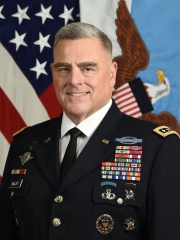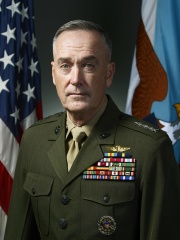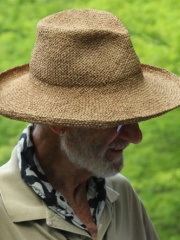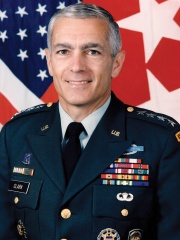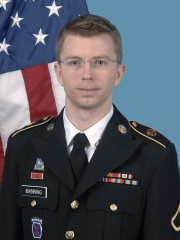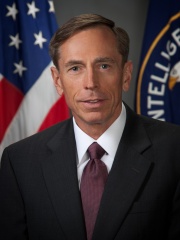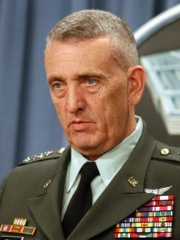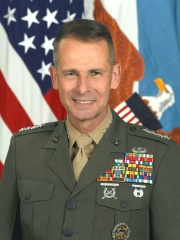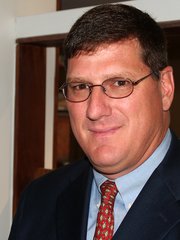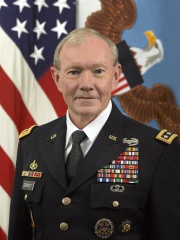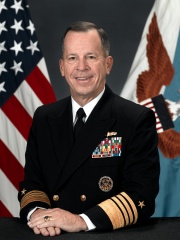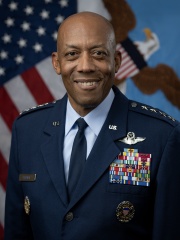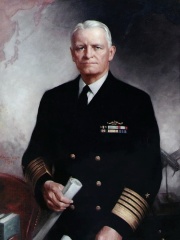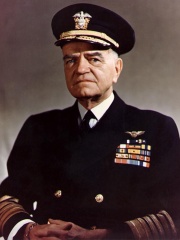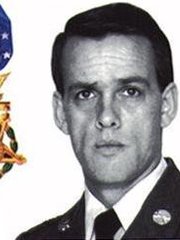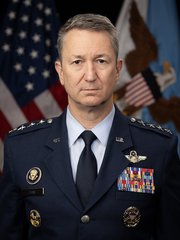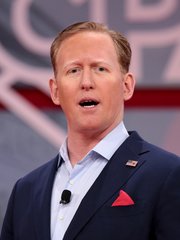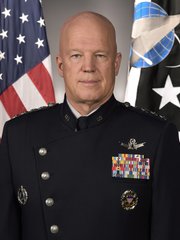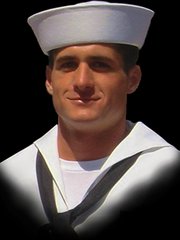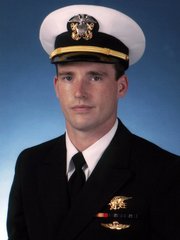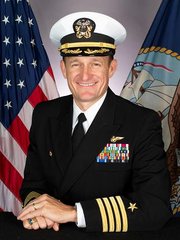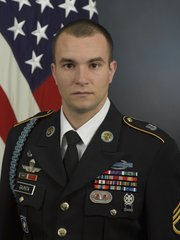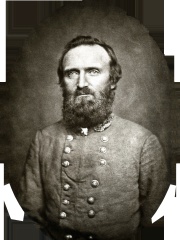
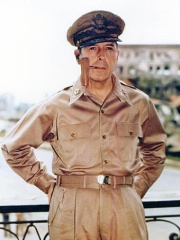
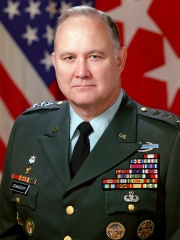
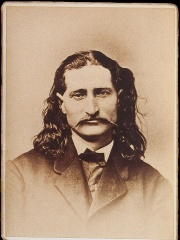
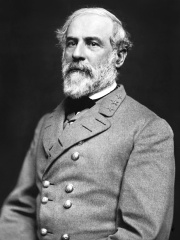
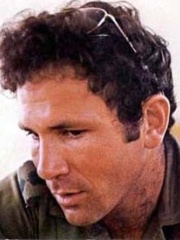
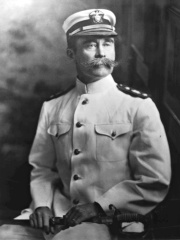
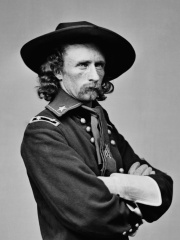
The Most Famous
MILITARY PERSONNELS from United States
This page contains a list of the greatest American Military Personnels. The pantheon dataset contains 2,058 Military Personnels, 213 of which were born in United States. This makes United States the birth place of the 2nd most number of Military Personnels.
Top 10
The following people are considered by Pantheon to be the top 10 most legendary American Military Personnels of all time. This list of famous American Military Personnels is sorted by HPI (Historical Popularity Index), a metric that aggregates information on a biography's online popularity. Visit the rankings page to view the entire list of American Military Personnels.

1. Stonewall Jackson (1824 - 1863)
With an HPI of 78.41, Stonewall Jackson is the most famous American Military Personnel. His biography has been translated into 51 different languages on wikipedia.
Thomas Jonathan "Stonewall" Jackson (January 21, 1824 – May 10, 1863) was a Confederate general and military officer who served during the American Civil War. He played a prominent role in nearly all military engagements in the eastern theater of the war until his death. Military historians regard him as one of the most gifted tactical commanders in U.S. history. Born in what was then part of Virginia (now in West Virginia), Jackson received an appointment to the United States Military Academy, graduating in the class of 1846. He served in the United States Army during the Mexican–American War, distinguishing himself at the Battle of Chapultepec. From 1851 to 1861, he taught at the Virginia Military Institute. When Virginia seceded from the United States in May 1861 after the Battle of Fort Sumter, Jackson joined the Confederate States Army. He distinguished himself commanding a brigade at the First Battle of Bull Run in July, providing crucial reinforcements and beating back a fierce Union assault. Thus Barnard E. Bee compared him to a "stone wall", which became his enduring nickname. Jackson performed exceptionally well in various campaigns over the next two years. On May 2, 1863, he was accidentally shot by Confederate pickets. He lost his left arm to amputation. Weakened by his wounds, he died of pneumonia eight days later. Jackson's death proved a severe setback for the Confederacy. After his death, his military exploits developed a legendary quality, becoming an important element of the pseudohistorical ideology of the "Lost Cause".

2. Douglas MacArthur (1880 - 1964)
With an HPI of 78.04, Douglas MacArthur is the 2nd most famous American Military Personnel. His biography has been translated into 86 different languages.
Douglas MacArthur (26 January 1880 – 5 April 1964) was an American general who served as a top commander during World War II and the Korean War, achieving the rank of General of the Army. He served with distinction in World War I; as chief of staff of the United States Army from 1930 to 1935; as Supreme Commander, Southwest Pacific Area, from 1942 to 1945 during WWII; as Supreme Commander for the Allied Powers overseeing the occupation of Japan from 1945 to 1951; and as head of the United Nations Command in the Korean War from 1950 to 1951. MacArthur was nominated for the Medal of Honor three times, and awarded it for his WWII service in the Philippines. He is one of only five people to hold the rank of General of the Army, and the only person to hold the rank of Field Marshal in the Philippine Army. MacArthur, the son of Medal of Honor recipient Arthur MacArthur Jr., was raised on Army posts in the Old West. He was valedictorian of the West Texas Military Academy, and First Captain at the U.S. Military Academy at West Point, where he graduated first in his class in 1903. During the 1914 U.S. occupation of Veracruz, he conducted a reconnaissance mission for which he was nominated for the Medal of Honor. In 1917, he was promoted from major to colonel and became chief of staff of the 42nd (Rainbow) Division. On the Western Front during World War I, he rose to the rank of brigadier general, was again nominated for a Medal of Honor, and was awarded the Distinguished Service Cross twice and the Silver Star seven times. From 1919 to 1922, MacArthur served as Superintendent of the U.S. Military Academy, where he initiated a series of reforms. His next posting was in the Philippines, where in 1924 he was instrumental in quelling the Philippine Scout Mutiny. In 1925, MacArthur became the Army's youngest major general at the age of 45, and in 1930 was appointed Chief of Staff of the U.S. Army. He was involved in the controversial expulsion of the Bonus Army protesters in Washington, D.C., in 1932, and organized the Civilian Conservation Corps. In 1935, MacArthur was appointed Military Advisor to the Commonwealth of the Philippines. He retired from the Army in 1937, but continued as an advisor and as a Field Marshal in the Philippine Army from 1936. MacArthur was recalled to active duty in July 1941 as commander of U.S. Army Forces in the Far East. A large portion of his air forces were destroyed on 8 December 1941 in the Japanese attack on Clark Field, and an invasion of the Philippines followed. MacArthur's forces withdrew to Bataan, where they held out until April 1942. In March 1942, MacArthur left nearby Corregidor Island and escaped to Australia, where he was appointed Supreme Commander of the Southwest Pacific Area in April. He promised that he would return to the Philippines, and for his defense of the islands was awarded the Medal of Honor in 1942. From Australia, he commanded the New Guinea campaign, and in October 1944 returned to the Philippines and led the campaign which liberated the islands. In December 1944, he was promoted to General of the Army. At the end of the war, MacArthur accepted the surrender of Japan on 2 September 1945. As the Supreme Commander for the Allied Powers and effective ruler of Japan, he oversaw the war crimes tribunals and the demilitarization and democratization of the country under its new constitution, introducing women's rights, labor unions, land reform, and civil liberties. In 1948, MacArthur made a brief bid for the Republican Party's nomination in that year's presidential election. During the Korean War, he led the United Nations Command with initial success, but suffered a series of major defeats after China's entry into the war in October 1950. MacArthur was contentiously removed from his command in Korea by President Harry S. Truman in April 1951. He later became chairman of the board of Remington Rand, and died in Washington, D.C., in 1964.

3. Norman Schwarzkopf Jr. (1934 - 2012)
With an HPI of 76.12, Norman Schwarzkopf Jr. is the 3rd most famous American Military Personnel. His biography has been translated into 37 different languages.
Herbert Norman Schwarzkopf Jr. ( SHWORTS-kof; 22 August 1934 – 27 December 2012) was a United States Army general. While serving as the commander of United States Central Command, he led all coalition forces in the Gulf War against Ba'athist Iraq. Born in Trenton, New Jersey, Schwarzkopf grew up in the United States and later in Iran. He was accepted by the United States Military Academy and was commissioned as a second lieutenant in the United States Army in 1956. After a number of initial training programs, Schwarzkopf interrupted a stint as an academy teacher and served in the Vietnam War, first as an adviser to the South Vietnamese Army and then as a battalion commander. Schwarzkopf was highly decorated in Vietnam and was awarded three Silver Stars, two Purple Hearts, and the Legion of Merit. Rising through the ranks after the Vietnam war, he later commanded the 24th Mechanized Infantry Division and was one of the commanders of the invasion of Grenada. Assuming command of United States Central Command in 1988, Schwarzkopf was called on to respond to the invasion of Kuwait in 1990 by the forces of Iraq under Saddam Hussein. Initially tasked with defending Saudi Arabia from Iraqi aggression, Schwarzkopf's command eventually grew to an international force of more than 750,000 troops. After diplomatic relations broke down, he planned and led Operation Desert Storm, an extended air campaign followed by a highly successful 100-hour ground offensive, which defeated the Iraqi Army and removed Iraqi troops from Kuwait in early 1991. Schwarzkopf was presented with military honors. He was, like his father, a freemason. He was also a Shriner and was a member of ANSAR Shrine until his death. Schwarzkopf retired shortly after the end of the war and undertook philanthropic ventures, only occasionally stepping into the political spotlight before his death from complications of pneumonia. A hard-driving military commander, easily angered, Schwarzkopf was considered an exceptional leader by many biographers and was noted for his abilities as a military diplomat and in dealing with the press.

4. Wild Bill Hickok (1837 - 1876)
With an HPI of 76.00, Wild Bill Hickok is the 4th most famous American Military Personnel. His biography has been translated into 30 different languages.
James Butler Hickok (May 27, 1837 – August 2, 1876), better known as "Wild Bill" Hickok, was a folk hero of the American Old West known for his life on the frontier as a soldier, scout, lawman, cattle rustler, gunslinger, gambler, showman, and actor, and for his involvement in many famous gunfights. He earned a great deal of notoriety in his own time, much of it bolstered by the many outlandish and often fabricated tales he told about himself. Some contemporaneous reports of his exploits are known to be fictitious, but they remain the basis of much of his fame and reputation. Hickok was born and raised on a farm in northern Illinois at a time when lawlessness and vigilante activity were rampant because of the influence of the "Banditti of the Prairie". Drawn to this criminal lifestyle, he headed west at age 18 as a fugitive from justice, working as a stagecoach driver and later as a lawman in the frontier territories of Kansas and Nebraska. He served in and spied for the Union army during the American Civil War and gained publicity after the war as a scout, marksman, actor, and professional gambler. He was involved in several notable shootouts during the course of his life. In 1876, Hickok was shot and killed while playing poker in a saloon in Deadwood, Dakota Territory (present-day South Dakota) by Jack McCall, an unsuccessful gambler. The hand of cards that he supposedly held at the time of his death has become known as the dead man's hand: two pairs; black aces and eights. Hickok remains a popular figure of frontier history. Many historic sites and monuments commemorate his life, and he has been depicted numerous times in literature, film, and television. He is chiefly portrayed as a protagonist, although historical accounts of his actions are often controversial, and much of his career is known to have been exaggerated both by himself and by contemporary mythmakers. Hickok claimed to have shot numerous gunmen in his lifetime, and he killed six or seven, all between 1861 and 1871 according to Joseph G. Rosa, Hickok's biographer and the foremost authority on him.
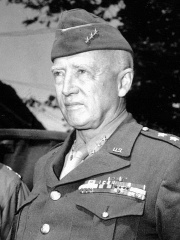
5. George S. Patton (1885 - 1945)
With an HPI of 75.61, George S. Patton is the 5th most famous American Military Personnel. His biography has been translated into 57 different languages.
George Smith Patton Jr. (11 November 1885 – 21 December 1945) was a general in the United States Army who commanded the Seventh Army in the Mediterranean Theater of World War II, then the Third Army in France and Germany after the Allied invasion of Normandy in June 1944. Born in 1885, Patton attended the Virginia Military Institute and the United States Military Academy at West Point. He studied fencing and designed the M1913 Cavalry Saber, more commonly known as the "Patton Saber." He competed in the modern pentathlon at the 1912 Summer Olympics in Stockholm, Sweden, finishing in fifth place. Patton entered combat during the Pancho Villa Expedition of 1916, the United States' first military action using motor vehicles. He fought in World War I as part of the new United States Tank Corps of the American Expeditionary Forces: he commanded the U.S. tank school in France, then led tanks into combat and was wounded near the end of the war. In the interwar period, Patton became a central figure in the development of the army's armored warfare doctrine, serving in numerous staff positions throughout the country. At the United States' entry into World War II, he commanded the 2nd Armored Division. Patton led U.S. troops into the Mediterranean theater with an invasion of Casablanca during Operation Torch in 1942, and soon established himself as an effective commander by rapidly rehabilitating the demoralized II Corps. He commanded the U.S. Seventh Army during the Allied invasion of Sicily, where he was the first Allied commander to reach Messina. There he was embroiled in controversy after he slapped two shell-shocked soldiers, and was temporarily removed from battlefield command. He was assigned a key role in Operation Fortitude, the Allies' military deception campaign for Operation Overlord. At the start of the Western Allied invasion of France, Patton was given command of the Third Army, which conducted a highly successful rapid armored drive across France. Under his decisive leadership, the Third Army took the lead in relieving beleaguered American troops at Bastogne during the Battle of the Bulge, after which his forces drove deep into Nazi Germany by the end of the war. During the Allied occupation of Germany, Patton was named military governor of Bavaria, but was relieved for making aggressive statements towards the Soviet Union and questioning denazification. Patton was also a known antisemite. He commanded the United States Fifteenth Army for slightly more than two months. Severely injured in an auto accident, he died in Germany twelve days later, on 21 December 1945. Patton's colorful image, hard-driving personality, and success as a commander were at times overshadowed by his controversial public statements. His philosophy of leading from the front, and his ability to inspire troops with attention-getting, vulgarity-laden speeches, such as his famous address to the Third Army, were received favorably by his troops, but much less so by a sharply divided Allied high command. His sending the doomed Task Force Baum to liberate his son-in-law, Lieutenant Colonel John K. Waters, from a prisoner-of-war camp further damaged his standing with his superiors. His emphasis on rapid and aggressive offensive action proved effective, and he was regarded highly by his opponents in the German High Command. The 1970 Oscar-winning biographical film Patton helped popularize his image.

6. Robert E. Lee (1807 - 1870)
With an HPI of 75.20, Robert E. Lee is the 6th most famous American Military Personnel. His biography has been translated into 83 different languages.
Robert Edward Lee (January 19, 1807 – October 12, 1870) was a Confederate general whose early actions in the American Civil War led to his appointment as the overall commander of the Confederate States Army near the end of the war. He led the Army of Northern Virginia, the Confederacy's most powerful army, from 1862 until its surrender in 1865, earning a reputation as one of the war's most skilled tacticians. A son of Revolutionary War officer Henry "Light Horse Harry" Lee III, Lee was a top graduate of the United States Military Academy and an exceptional officer and military engineer in the United States Army for 32 years. He served across the United States, distinguished himself during the Mexican–American War, and was Superintendent of the United States Military Academy. He married Mary Anna Custis, great-granddaughter of George Washington's wife Martha. He supported the legality of slavery and held hundreds of slaves. When Virginia declared its secession from the Union in 1861, Lee chose to follow his home state, despite his desire for the country to remain intact and an offer of a senior Union command. During the first year of the Civil War, he served in minor combat operations and as a senior military adviser to Confederate president Jefferson Davis. Lee took command of the Army of Northern Virginia in June 1862 during the Peninsula campaign following the wounding of Joseph E. Johnston. He succeeded in driving the Union Army of the Potomac under George B. McClellan away from the Confederate capital of Richmond during the Seven Days Battles, but he was unable to destroy McClellan's army. Lee then overcame Union forces under John Pope at the Second Battle of Bull Run in August. His invasion of Maryland that September ended with the inconclusive Battle of Antietam, after which he retreated to Virginia. Lee won two major victories at Fredericksburg and Chancellorsville before launching a second invasion of the North in the summer of 1863, where he was decisively defeated at the Battle of Gettysburg by the Army of the Potomac under George Meade. He led his army in the minor and inconclusive Bristoe campaign that fall before General Ulysses S. Grant took command of Union armies in the spring of 1864. Grant engaged Lee's army in bloody but inconclusive battles at the Wilderness and Spotsylvania before the lengthy Siege of Petersburg, which was followed in April 1865 by the capture of Richmond and the destruction of most of Lee's army, which he finally surrendered to Grant at Appomattox Court House. In 1865, Lee became president of Washington College, now Washington and Lee University, in Lexington, Virginia; as president of the college, he supported reconciliation between the North and South. Lee accepted the termination of slavery provided for by the Thirteenth Amendment, but opposed racial equality for African Americans. After his death in 1870, Lee became a cultural icon in the South and is largely hailed as one of the Civil War's greatest generals. As commander of the Army of Northern Virginia, he fought most of his battles against armies of significantly larger size, and managed to win many of them. Lee built up a collection of talented subordinates, most notably James Longstreet, Stonewall Jackson, and J. E. B. Stuart, who along with Lee were critical to the Confederacy's battlefield success. But his two major strategic offensives into Union territory ended in failure, and his aggressive and risky tactics, especially at Gettysburg, resulted in high casualties at a time when the Confederacy had a shortage of manpower. His battlefield record, his views on race and slavery, and his legacy have been the subject of continuing debate and historical controversy.

7. Yonatan Netanyahu (1946 - 1976)
With an HPI of 75.02, Yonatan Netanyahu is the 7th most famous American Military Personnel. His biography has been translated into 34 different languages.
Yonatan "Yoni" Netanyahu (Hebrew: יוֹנָתָן "יוֹנִי" נְתַנְיָהוּ, pronounced [jonaˈtan ˈjoni netanˈjahu]; March 13, 1946 – July 4, 1976) was an Israeli military officer who commanded Sayeret Matkal during the Entebbe raid. The raid was launched in response to the 1976 hijacking of an international civilian passenger flight from Israel to France by Palestinian and German militants, who took control of the aircraft during a stopover in Greece and diverted it to Libya and then to Uganda, where they received support from Ugandan dictator Idi Amin. Though Israel's counter-terrorist operation was a success, with 102 of the 106 hostages being rescued, Netanyahu was killed in action – the only Israeli soldier killed during the crisis. The eldest son of the Israeli professor Benzion Netanyahu and brother of Israeli prime minister Benjamin Netanyahu, Yonatan was born in New York City and spent much of his youth in the United States, where he attended high school. After serving in the Israeli military during the Six-Day War, he briefly attended Harvard University before transferring to the Hebrew University of Jerusalem in 1968; soon thereafter, he left his studies and returned to military service in Israel. He joined Sayeret Matkal in the early 1970s and was awarded the Medal of Distinguished Service for his conduct in the Yom Kippur War. After his death, Operation Entebbe was renamed "Operation Yonatan" in his honor.

8. Robert Peary (1856 - 1920)
With an HPI of 73.23, Robert Peary is the 8th most famous American Military Personnel. His biography has been translated into 59 different languages.
Robert Edwin Peary (; May 6, 1856 – February 20, 1920) was an American explorer and officer in the United States Navy who made several expeditions to the Arctic in the late 19th and early 20th centuries. He was long credited as being the discoverer of the geographic North Pole in April 1909, having led the first expedition to have claimed this achievement, although it is now considered unlikely that he actually reached the Pole. Peary was born in Cresson, Pennsylvania, but, following his father's death at a young age, was raised in Cape Elizabeth, Maine. He attended Bowdoin College, then joined the United States Coast and Geodetic Survey as a draftsman. He enlisted in the navy in 1881 as a civil engineer. In 1885, he was made chief of surveying for the Nicaragua Canal, which was never built. He visited the Arctic for the first time in 1886, making an unsuccessful attempt to cross Greenland by dogsled. In the Peary expedition to Greenland of 1891–1892, he was much better prepared, and by reaching Independence Fjord in what is now known as Peary Land, he proved conclusively that Greenland was an island. He was one of the first Arctic explorers to study Inuit survival techniques. During an expedition in 1894, he was the first Western explorer to reach the Cape York meteorite and its fragments, which were then taken from the native Inuit population who had relied on it for creating tools. During that expedition, Peary deceived six indigenous individuals, including Minik Wallace, into traveling to the United States with him by promising they would be able to return with tools, weapons and gifts within the year. This promise was unfulfilled and four of the six Inuit died of illnesses within a few months. On his 1898–1902 expedition, Peary set a new "Farthest North" record by reaching Greenland's northernmost point, Cape Morris Jesup. Peary made two more expeditions to the Arctic, in 1905–1906 and in 1908–1909. During the latter, he claimed to have reached the North Pole. Peary received several learned society awards during his lifetime, and, in 1911, received the Thanks of Congress and was promoted to rear admiral. He served two terms as president of the Explorers Club before retiring in 1911. Peary's claim to have reached the North Pole was widely debated along with a competing claim made by Frederick Cook, but eventually won widespread acceptance. In 1989, British explorer Wally Herbert concluded Peary did not reach the pole, although he may have come within 60 mi (97 km).

9. George Armstrong Custer (1839 - 1876)
With an HPI of 72.93, George Armstrong Custer is the 9th most famous American Military Personnel. His biography has been translated into 55 different languages.
George Armstrong Custer (December 5, 1839 – June 25, 1876) was a United States Army officer and cavalry commander in the American Civil War and the American Indian Wars. Custer graduated in 1861 from the United States Military Academy at West Point, New York, last in his class. Custer's initial class had consisted of 108 candidates of whom 68 men passed the entrance exam. However, following the start of the American Civil War, many of Custer's classmates departed the academy in a series of resignations to fight for their respective states. By his graduation date, Custer ranked 34th among 34 remaining classmates. Nonetheless, Custer achieved a higher military rank than any other U.S. Army officer in his class. Following graduation, he worked closely with future Union Army Generals George B. McClellan and Alfred Pleasonton, both of whom recognized his abilities as a cavalry leader. He was promoted in the early American Civil War (1861–1865), to brevet brigadier general of volunteers when only aged 23. Only a few days afterwards, he fought at the pivotal Battle of Gettysburg in Pennsylvania in early July 1863, where he commanded the Michigan Brigade. Despite being outnumbered, the new General Custer defeated Confederate States Army cavalry of General J. E. B. Stuart's attack at East Cavalry Field on the crucial third day of the Gettysburg clash. In 1864, Custer served in the Overland Campaign and with Union cavalry commander General Philip Sheridan's army in the Shenandoah Valley campaigns later that summer, defeating Confederate General Jubal Early at Cedar Creek. In the last year of the war of 1865, Custer destroyed or captured the remainder of Early's forces at the Battle of Waynesboro in Western Virginia. Custer's division blocked the Southern Army of Northern Virginia's final retreat from their fallen capital city of Richmond in early April 1865, and Custer received the first flag of truce from the exhausted Confederates. He was present at the Army of Northern Virginia commanding General Robert E. Lee's surrender ceremony at the McLean House to Union Army General-in-Chief Ulysses S. Grant at Appomattox Court House, Virginia. After the war, Custer was commissioned as a lieutenant colonel in the standing Regular Army and sent west to fight in the ongoing Indian Wars, mainly against the Lakota / Sioux and other Great Plains native peoples. On June 25, 1876, while leading the Army's 7th Cavalry Regiment at the Battle of the Little Bighorn in the southeastern Montana Territory against a coalition of Western Native American tribes, he was killed along with every soldier of the five companies he led of his regiment. This event became known as "Custer's Last Stand". Custer's dramatic end was as controversial as the rest of his life and career, and the reaction to his life remains divided, even 150 years later. His mythologized status in American history was partly established through the energetic lobbying of his adoring wife Elizabeth Bacon "Libbie" Custer (1842–1933) throughout her long widowhood which spanned six decades, well into the 20th century.
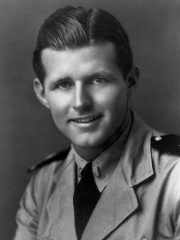
10. Joseph P. Kennedy Jr. (1915 - 1944)
With an HPI of 72.56, Joseph P. Kennedy Jr. is the 10th most famous American Military Personnel. His biography has been translated into 24 different languages.
Joseph Patrick Kennedy Jr. (July 25, 1915 – August 12, 1944) was an American naval aviator who was a lieutenant in the U.S. Navy. He was a member of the Kennedy family and the eldest of the nine children born to Joseph P. Kennedy Sr. and Rose Fitzgerald Kennedy. During World War II, Kennedy was killed in action while serving as a land-based patrol bomber pilot, and posthumously awarded the Navy Cross. Kennedy's father had aspirations for him to become President of the United States. Kennedy was a delegate to the 1940 Democratic National Convention and planned to run for a seat in the U.S. House of Representatives after his military service as the first stepping stone on the path to the presidency. Kennedy's death while participating in Operation Aphrodite in August 1944 caused his father to transfer his aspirations to his next-oldest son, John F. Kennedy, who followed the path first planned for his older brother by advancing from the House to the U.S. Senate and then to the presidency.
People
Pantheon has 213 people classified as American military personnels born between 1718 and 1987. Of these 213, 30 (14.08%) of them are still alive today. The most famous living American military personnels include Mark Milley, Joseph Dunford, and Frank Serpico. The most famous deceased American military personnels include Stonewall Jackson, Douglas MacArthur, and Norman Schwarzkopf Jr.. As of April 2024, 10 new American military personnels have been added to Pantheon including Scott Ritter, Gary Gordon, and Dan Caine.
Living American Military Personnels
Go to all RankingsMark Milley
1958 - Present
HPI: 69.05
Joseph Dunford
1955 - Present
HPI: 63.13
Frank Serpico
1936 - Present
HPI: 62.37
Wesley Clark
1944 - Present
HPI: 61.45
Chelsea Manning
1987 - Present
HPI: 61.29
David Petraeus
1952 - Present
HPI: 60.49
Tommy Franks
1945 - Present
HPI: 58.12
Peter Pace
1945 - Present
HPI: 55.31
Scott Ritter
1961 - Present
HPI: 54.98
Martin Dempsey
1952 - Present
HPI: 54.45
Michael Mullen
1946 - Present
HPI: 54.38
Charles Q. Brown Jr.
1962 - Present
HPI: 54.07
Deceased American Military Personnels
Go to all RankingsStonewall Jackson
1824 - 1863
HPI: 78.41
Douglas MacArthur
1880 - 1964
HPI: 78.04
Norman Schwarzkopf Jr.
1934 - 2012
HPI: 76.12
Wild Bill Hickok
1837 - 1876
HPI: 76.00
George S. Patton
1885 - 1945
HPI: 75.61
Robert E. Lee
1807 - 1870
HPI: 75.20
Yonatan Netanyahu
1946 - 1976
HPI: 75.02
Robert Peary
1856 - 1920
HPI: 73.23
George Armstrong Custer
1839 - 1876
HPI: 72.93
Joseph P. Kennedy Jr.
1915 - 1944
HPI: 72.56
Chester W. Nimitz
1885 - 1966
HPI: 72.04
William Halsey Jr.
1882 - 1959
HPI: 71.99
Newly Added American Military Personnels (2025)
Go to all RankingsScott Ritter
1961 - Present
HPI: 54.98
Gary Gordon
1960 - 1993
HPI: 52.59
Dan Caine
1968 - Present
HPI: 48.59
Robert J. O'Neill
1976 - Present
HPI: 46.19
John W. Raymond
1962 - Present
HPI: 43.26
Michael A. Monsoor
1981 - 2006
HPI: 42.97
Michael P. Murphy
1976 - 2005
HPI: 41.47
Kimberly Cheatle
1972 - Present
HPI: 40.55
Brett Crozier
1970 - Present
HPI: 35.92
Salvatore Giunta
1985 - Present
HPI: 34.58
Overlapping Lives
Which Military Personnels were alive at the same time? This visualization shows the lifespans of the 25 most globally memorable Military Personnels since 1700.

